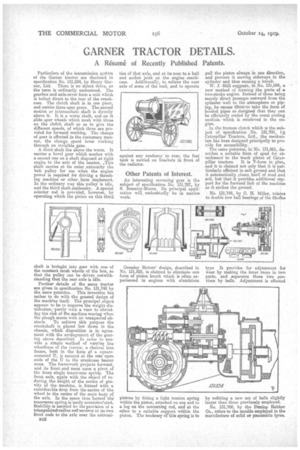GARNER TRACTOR DETAILS.
Page 24

If you've noticed an error in this article please click here to report it so we can fix it.
A Résumé of Recently Published Patents.
Particulars of the transmission system of the Garner tractor are disclosed in specification No. 131,834, by Henry Garner, Ltd. There is no direct drive, as the term is ordinarily understood. The gearbox and axlaeover form a unit which is bolted direct to the rear of the crankcase. The dutch shaft is in one piece, and carries three spur gears. The second motion or intermediate shaft is directly above it. It is a worm shaft, and on it slide spur wheels which mesh with those on the clutch shaft so as to give the different speeds, of which three are provided for forward working. The change of gear is effected in the customary manner, the change speed lever working through an invisible, gate.
A third shaft lies above the worm. It carries a bevel gear which meshes with a second one on a shaft disposed at right angles to the axis of the tractor. ,This shaft carries at its outer extremity the belt pulley for use when the engine power is required for driving a, threshing machine or other, farm implement. In the ordinary way this pulley is idle, and the third shaft stationary. A special selector rod is provided, however, by operating which the pinion on this third shaft is brought into gear with one of the constant mesh wheels of the box, so that the pulley can be driven notwithstanding that the rear axle is idle.
Further details of the eame tractor are given in specification No. 131,740 by the same patentee. This invention has rather to do with the general design of the machine itself. The principal object appears to he to improve the weight distribution,-partly with a view to obviating the risk of the marline rearing when the plough meets with an enexpeeted ob stacle, To achieve this purpose the crankshaft is placed low down in the chassis, which disposition is in agreement with the arrangement of the gearing above described. In order to provide a simple method of varying the wheelbase of the tractor, a channel iron frame, bent in the form a a squarecornered U, is secured at the nstrz open ends of the II to the crankcase bearer arms. The framework projects forward, and its front.,end rests upon a pivot of the front single transverse spring. The front axle, again with the object of reducing the height of the centre of gravity of the machine, is formed with a • considereble drop from the centre of the wheel to the centre of the main body of the axle. In the space thus formed the transverse spring.is easily accommodated. Stability is assisted by the provision of a triangulateekradiuslodssecureo at its two front ends to the axle near the extremi
B42 ties of that axle, and at its rear to a ball and socket joint on the engine crankcase. Additionally, to relieve the rear axle of some of the load, and to operate against any tendency to rear, the fuel tank is carried OR bracket's in front of the radiator.
Other Patents of Interest.
An interesting reversing gear is the subject of specification No. 131,787, by S. Bramley-Moere. Its principal application will, undoubtedly be in marine work.
Crossley Motors' design, described in No. 131,828, is claimed to eliminate one form of piston knock which is often experienced in engines with aluminium
pistons by fitting a light tension spring within the piston, attached on one end to a lug on the connecting rod, and at the other to a suitable support within the piston. The tendency of thisspring is to
pull the piston always in one direction, and prevent it moving sideways in the cylinder and thus causing a knock.
W. J. Still suggeats, in No. 131,694, a new method of terming the ports of a two-stroke engine. Instead of these being merely direct passages outward from the cylinder wall to the atmosphere or piping, he causes tteresto take the form of hooded pipes so designed that they can be efficiently cooled by the usual cooling mediuin .which is employed in the en, gin-e.
In the friction dutch which is the subject of specification No. 131,700, ly Caterpillar Tractors, Ltd., the mechaniern has been designed principally to provide for accessibility. The same patentee, in No. 131,861, describes a suitable form of spud for attachment to the track plates of Cater
pillar tractors. It is -V-form in plan, an,d it is claimed not only that it is par, ticularly efficient in soft ground and that it automatically clears itself of mud and soil, but that it provides additional snipport for the forward link of the machine as it strikes the ground.
No. 131,744, by C. H. Miller, relates to double row ball bearings of the Skefko type It provides for adjustment for wear by Making the inner races in two parts, and separates these two portions by balls. Adjustment is effected by refitting a new set of balls slightly larger than those previously employed. No, 131,760, by the Dunlop Rubber Co., refers to the moulds employed in the marl:facture of solid or pneumatic tyres.
























